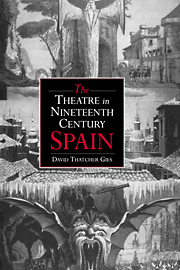Book contents
- Frontmatter
- Contents
- Preface
- Introduction: literary history and canon formation
- 1 Spanish theatre in the nineteenth century. (An overview)
- 2 Theatre and dictatorship: from Napoleon to Fernando VII
- 3 Romanticism and beyond (1834-1849)
- 4 The theatre at mid-century
- 5 “This woman is quite a man!”: women and the theatre (1838-1900)
- 6 High comedy, and low
- 7 Conflicting visions: neo-Romanticism, ridicule, and realism
- Conclusion
- Bibliography
- Index of names
- Index of plays
Introduction: literary history and canon formation
Published online by Cambridge University Press: 07 May 2010
- Frontmatter
- Contents
- Preface
- Introduction: literary history and canon formation
- 1 Spanish theatre in the nineteenth century. (An overview)
- 2 Theatre and dictatorship: from Napoleon to Fernando VII
- 3 Romanticism and beyond (1834-1849)
- 4 The theatre at mid-century
- 5 “This woman is quite a man!”: women and the theatre (1838-1900)
- 6 High comedy, and low
- 7 Conflicting visions: neo-Romanticism, ridicule, and realism
- Conclusion
- Bibliography
- Index of names
- Index of plays
Summary
In 1978 Hayden White wrote, “Every representation of the past has specifiable ideological implications,” a statement which rings particularly true for nineteenth-century Spanish theatre. The history of the theatre in nineteenth-century Spain is usually told through the study of certain selected masterworks, plays which have been read and studied in university classrooms and which have been said to have had a major impact on the direction of theatrical activity in the last century. Students are all familiar with the shocking rebellion of the Duque de Rivas's Don Alvaro o la fuerza del sino (Don Alvaro or the Force of Destiny), the poetic beauty of Zorrilla's Don Juan Tenorio, Tamayo's neatly structured Un drama nuevo (A New Drama), Galdós's dramatic renderings of his concerns for the Spanish middle-class, or Echegaray's delicious excesses of honor and betrayal. Yet these works do not necessarily reflect what really happened in the theatre in nineteenth-century Spain nor do they reveal much about what changes took place in the mind-set of the public going to see them. They certainly do not tell the whole story. In fact, they frequently provide false clues as to the development of the theatre by leading modern readers to assume that they represented the dominant trends, the most popular theatre of their time, or an organic “progress” throughout the century. In many cases, nothing could be further from the truth.
- Type
- Chapter
- Information
- The Theatre in Nineteenth-Century Spain , pp. 1 - 5Publisher: Cambridge University PressPrint publication year: 1994

